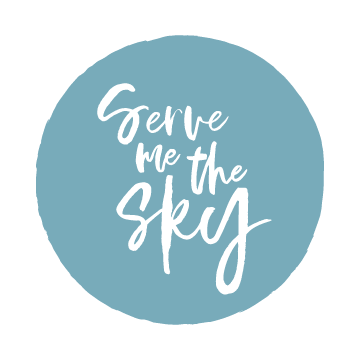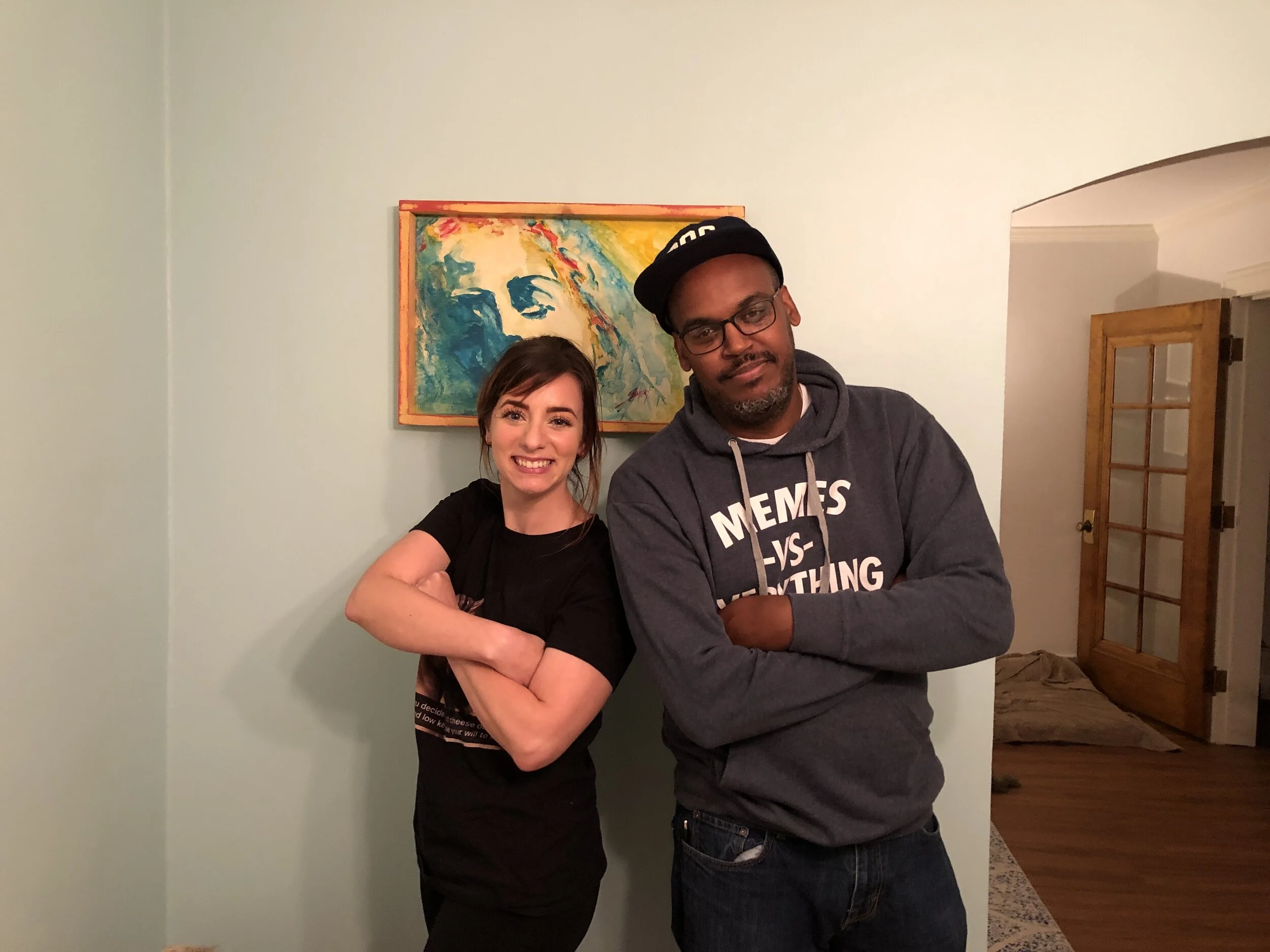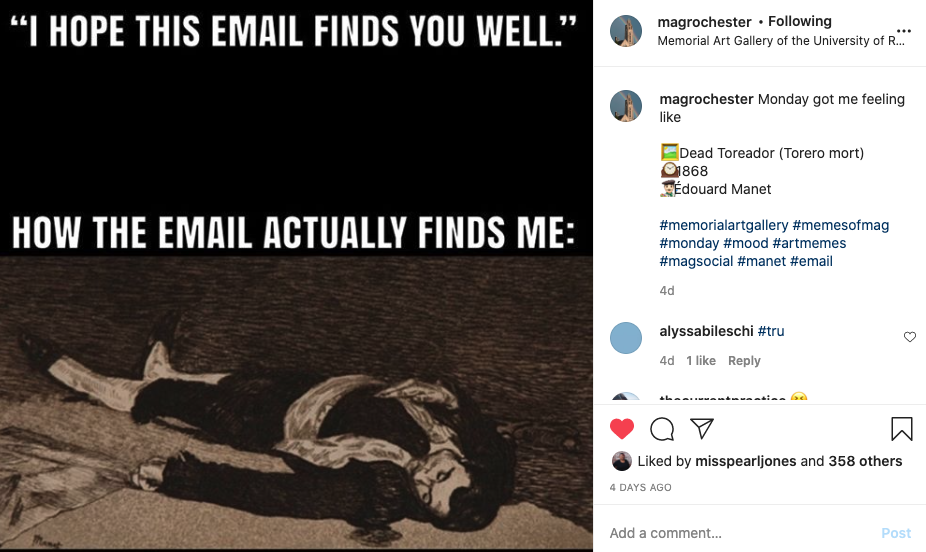A Conversation with Quajay Donnell & Jessica Gasbarre: For the Love of Memes
/This is the ninth post in the “A Conversation With” series, where I interview talented folks about their areas of expertise, whether that’s social media, communications, or PR. You can read past entries in the series here.
This month, I interviewed two meme enthusiasts, Quajay Donnell and Jessica Gasbarre. We discussed the definition of a meme, what makes a good one, and why they’re so popular. I hope you enjoy their insights!
Tell me about yourself and how you use social media.
Jessica: I work at the Memorial Art Gallery as the Engagement Manager. My job is to break down the barriers of art and make it fun, and one way I do that is through memes. I use social media both personally and professionally.
Quajay: I’m a photographer; I mostly use memes for humor, and sometimes for awareness.
How do you define the term “meme”?
Quajay: I think of it as a funny image or video that is also topical. At its core, almost everything is a meme. Widespread, shared things that elicit some sort of response, whether it’s humor or awareness. The fly on Pence’s head during the VP debate is a good example; Biden’s marketing folks quickly came up with an image of Joe holding a flyswatter with a catchy tagline. Coming up with memes on an ongoing basis can be a whole job!
Jessica: One of the key things about memes is that they’re so memorable.
What first attracted you to making memes?
Jessica: I started making memes before I started working at MAG. When my nephew was first born, he’d make so many faces and I’d always wonder what he was thinking. I’d come up with funny captions and that was where it all started.
Quajay: The humor of it is probably what attracted me. I remember, I’d use Photoshop and the font was Impact, I’d put a line at the top and a line at the bottom. Now there are 50 apps for meme-making! I started off by just sharing memes, and then switched to making them. Now people ask me to make them!
Jessica: It’s so much pressure when someone asks you to make a meme!
Quajay: My favorite thing is to meme other people’s kids. People know we’re really good friends when I meme their kid! And now my nieces and nephews say, “Don’t make this a meme.”
What was the first meme you ever made?
Jessica: It was one of my older nephew, something about drinking a lot of milk and looking drunk.
Quajay: I can’t remember what my first meme was.
What’s your favorite meme?
Quajay: The Jordan crying meme when it first started. He was being really vulnerable, crying while getting inducted into the Hall of Fame, and now that meme is used for failure. I started seeing like 300 of them anytime something happened, and they lost some of the humor. But now when I see a fresh take on it, it’s funny again.
Jessica: Early on, at a Duke/Syracuse game, someone in the stands from Duke had a “Wegmans is overrated” sign, and in the meme version, the Syracuse coach is taking off his jacket to show a shirt that says “No one says Wegmans is overrated!”
What makes a good meme? Are there specific things that make a meme great?
An example of a dark meme by Jessica
Quajay: The timeliness of it is important, it can’t be like three days later. A pet peeve of mine is bad grammar in them. I’ll be like, “Man that’s a good one, but they used the wrong your/you’re.” Then I have to decide if I should share it or fix the grammar and then share it! Clarity of your message is important too. If the image or text is fuzzy, it’s not as good.
Jessica: It has to be a certain length, it can’t be too long. I have a lot of thoughts, so I struggle with writing memes that are the right length! You don’t want to lose the humor. I also like my memes with a bit of darkness to them.
How can businesses incorporate memes into their social media strategy? Should they? How do they do it without it seeming like they’re trying too hard?
Jessica: I don’t know that memes are for every business. Biden can get away with memes as part of his campaign because people have been making him into a meme since 2008. I’ve seen a lot of businesses using memes when I don’t think they should or it’s in poor taste.
Quajay: Businesses need to consider the timeliness of the meme and if it’s on brand. The local businesses I see using memes are usually on brand and funny, but some of the national chains show up three days late and it’s not funny. Like the Dolly Parton challenge, where you showed how you present yourself on four different social media platforms (Facebook, LinkedIn, Instagram, and Tinder). So many brands jumped on that! Like Doritos? Are you kidding me?!
What’s the best platform to share memes on? On Instagram, do memes fit better in Instagram Stories or as an in-feed post?
Quajay: It depends on the meme. I share family memes all the time on Facebook. My nephew is probably my favorite subject for memes. Depending on the subject, some memes are timeless and can live on your feed; others are your contribution at the moment in your Stories, and after 24 hours they’re done.
Jessica: For the MAG, we only do memes on our Instagram. Our audience is older on Facebook and has different expectations for content, and are often looking for something more academic and less playful.
Jessica, what kinds of questions do you get from your boss about memes? Was it difficult to justify using memes at an art museum?
Jessica: I’m really lucky, both my boss and our Director know about internet culture. Not all staff appreciate meme culture though. I once had to do a presentation about colloquialism and why memes are good for art museums! There’s a delicate balance to strike between preservation and accessibility.
Quajay: The way the MAG uses memes brings different people to the museum who might not otherwise think it’s for them. I think art memes are funnier than a lot of other memes. With art, you often don’t know the story behind the painting. There’s one meme that says “What if you found out you were the meme?” in a mirror image on the painting. That’s not what the painting is about, but it’s funny! When the MAG and other museums use memes, it allows people to come in and go, “Oh, that’s a funny meme, let me read about the artist and look up more of their work.” A lot of me learning about art in the last five years has come from memes.
Should memes have a CTA?
Jessica: Sometimes in the caption for the post we’ll include a CTA. For example, in a meme we did about “Live Laugh Love” signs in people’s houses, we encouraged people to learn more about the work of art and attend a virtual event.
Quajay: I’d include a CTA when promoting an event, like Cocktails with Creatives at the MAG.
How do you measure the ROI of a meme?
Jessica: We have a whole spreadsheet where we measure engagement and re-shares. The “I hope this email finds you well” meme was my best performing one yet!
Can memes be planned in advance, or do they have to be spontaneous?
Jessica: They have to be spontaneous.
Quajay: Usually they have to be spontaneous, but sometimes I’ll plan them ahead of time, like when I’m promoting an event. Sometimes I’ll see a great meme that’ll be more relevant on a certain day, like a meme about Columbus that hits better on Columbus Day, and hold onto it until that day.
What are some of the best apps to use for meme making?
Jessica: I used to use PowerPoint! Sometimes I use Snapchat. Mematic is another good one.
Quajay: Caption Meme is good for when you just want a line at the top and a line at the bottom. Keynote on my phone works well too--I can type, size, and export as a jpg. It also syncs to my computer!
What’s the biggest thing you’ve learned about memes?
Jessica: Know your audience. It’s a lesson I have to re-learn all the time.
Quajay: They’re not always going to be funny to everyone.
What is it about memes that we enjoy so much? Why do they resonate?
Jessica: I enjoy art memes because it’s so funny to see classic, highbrow art with a hilarious, dodgy caption. You wouldn’t usually pair the two things together.
Quajay: Sometimes you can identify with what’s happening. A lot of people will post a meme and caption it “mood.” It’s a way to say “This is something I identify with.”
Jessica: There was a class at Nazareth about the psychology of memes. They talked about how memes are almost an avoidance behavior, where you post a funny meme instead of dealing with your problems.
Quajay: I remember a great meme about therapy where the patient says to the therapist, “Show me a series of memes and I’ll point to the one that’s mood.”
Any final thoughts?
Jessica: I’m trying to keep it light and fun, especially in 2020 and as we go into November. The world needs more fun.
Quajay: I remember four years ago, I was sharing lighthearted memes that weren’t taking the election seriously. Now I steer away from memes making fun of the election. I look at memes from four years ago and think of what I wish I had posted. We need to be aware and vote. Instead, I’m posting things like “Felt cute, might vote later.”
Quajay encouraging folks to vote
Where can people find you/your work?
Jessica: You can follow the MAG on Instagram at @magrochester and me at @artstagram5.
For more social media insights, check out my unboring email newsletter!







